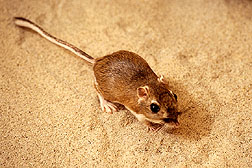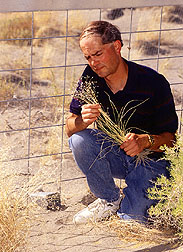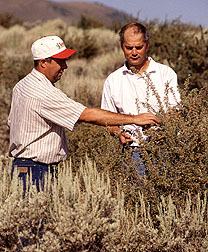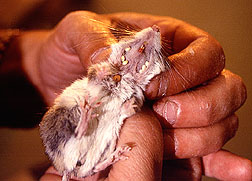Range Reseeding Relies on Rodents
|
|
A key to establishing rangeland plants may be the kangaroo rats and chipmunks that eat the seeds.
Land managers often reseed areas disturbed by fire or mining to hold the soil in place, provide food for livestock and wildlife, and ward off invasive weeds. When possible, they try to use plants native to the area they are planting. But their success can depend not only on soil type and precipitation, but on the local animals as well.
"A revegetation plan is likely to fail if rodent populations aren't considered," says Agricultural Research Service animal ecologist William S. Longland.
That's because Longland and others have found that certain native plants depend on rodents for germination in the wild. Longland works at the ARS Ecology of Temperate Desert Rangelands Laboratory in Reno, Nevada. He's studying local wildlife to develop the best strategies for establishing native plants on the range.
Two of the most economically important plants in Nevada's Great Basin are Indian ricegrass and the shrub called antelope bitterbrush. The basin extends from the Sierra Nevada and Oregon-Idaho border east to the Wasatch Range in Utah and south to the Mojave Desert.
"In the winter, many Western ranchers rely on rangeland grasses to feed their cattle, and mule deer depend on shrubs like antelope bitterbrush," says ARS rangeland scientist James A. Young, who leads the Reno laboratory.
Frosty Tipton is one of those ranchers. He feeds about 1,100 cows on 250,000 acres of owned and leased land.
"If we didn't have access to rangeland, we'd have to put up hay for the winter," he says. "But we don't own enough land to produce up to 1 ton of hay needed for each cow per month—I don't know what our ranch would do without the winter range," he says.
Planting's a Costly Affair
Replanting with native seeds can get expensive. Indian ricegrass seeds cost between $5 and $30 per pound, depending on whether the variety is commercially grown or locally harvested from the wild. Antelope bitterbrush seed costs up to $18 per pound. For comparison, a non-native grass, crested wheatgrass, sells for only $1.70 per pound.
That's where understanding the seed-eating granivores comes in.
Longland just finished a 4-year study of Great Basin granivores, including birds, ants, and rodents. He found that birds have little influence, because other granivores generally beat them to the seeds. Ants eat the seeds or take them too far below ground to germinate. But the rodents can be essential.
Labor That's Wild and Free
In field experiments, Longland discovered that kangaroo rats and their relatives were responsible for more than 90 percent of the germination and establishment of Indian ricegrass seedlings.
"These rodents gather hundreds of seeds in their cheek pouches and then bury them in shallow hiding places, or caches," Longland says. "Later, they'll return and eat the seeds, but some get missed. The caches put the seeds in an ideal location for germination and protect them from other rodents and ants," he says. Scientists also believe that chemicals or friendly microbes in the cheek pouches break the seeds' dormancy, another needed step before seedlings can sprout.
|
|
Steven B. Vander Wall, an animal ecologist with the University of Nevada at Reno, found that antelope bitterbrush has an ever greater association with chipmunks and squirrels.
In contrast to these beneficial effects on natural seedlings, however, rodents can hamper artificial revegetation efforts by eating the planted seeds.
"With some traditional reseeding operations, rodents will go up the closely spaced rows of shallow-planted seeds just like they're in a buffet line," Longland says.
A Battle of Wits
Young, Longland, and colleagues have come up with two strategies for outwitting the crafty rodents.
The first is to plant fewer seeds—but at a greater depth and more widely spaced than traditional seeding operations. "Normally, the shallow-planted seeds would have a better chance to germinate," says Young. "But planting deeper seems to deter the rodents, so a greater percentage of the total planted stays in place long enough to sprout."
Another plus: An ultra-low seeding rate reduces the cost of native plant restoration up to 25-fold.
Since this technique was developed in 1994, it has become the standard for seeding Indian ricegrass in the Great Basin. The tricky part is getting the seed drills to plant the seeds sparsely. Adding an inert material like vermiculite or rice hulls in the drill box allows the equipment to work normally but spreads out placement of the seeds.
The second approach takes advantage of the animals' natural tendency to cache seeds.
"Kangaroo rats and other caching rodents don't eat most of the seeds they collect until later," Longland says. The new method, still under development, would allow the rodents to cache the newly planted, desired seeds. Then, land managers would provide a cheaper commercial seed that the rodents prefer, such as millet. This cheaper seed would be a decoy, or sacrifice—recovered first from the cache, since the rodents like it better, leaving more of the native seeds in the ground to germinate.
"Our tests to date indicate this could work," Longland says. Rodents did like the millet better than the native plant, four-wing saltbush. But so far, they haven't found anything the animals like better than Indian ricegrass.
The most immediate practical application for Longland's work may be as a predictive tool.
"If we know which rodents live in an area that has been disturbed, we should be able to estimate how the area will recover without artificial reseeding," he says.
For example, in 1985, a fire burned 6,800 acres near Flanigan, Nevada, by the California border. Land managers planted seeds to stabilize the area. The next year, lush growth of Indian ricegrass appeared—but it was not from the seeds in the revegetation mixture.
"If we'd had a good understanding of the rodent-Indian ricegrass ecology at that time, we might have been able to save the time and money that went into the reseeding," Longland says. "In some cases, disturbed areas will recover naturally."—By Kathryn Barry Stelljes. To reach the author, contact Marcia Wood, Agricultural Research Service, Information Staff, 800 Buchanan St., Albany, CA 94710; phone (510) 559-6070.
William S. Longland is at the USDA-ARS Ecology of Temperate Desert Rangelands Laboratory, 920 Valley Rd., Reno, NV 89512; phone (702) 784-6057, fax (702) 784-1712.
"Range Reseeding Relies on Rodents" was published in the January 1998 issue of Agricultural Research magazine. Click here to see this issue's table of contents.










